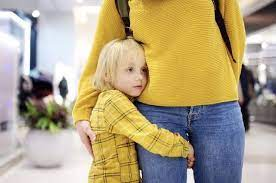Separation anxiety is a common and natural part of a child’s development, typically occurring between the ages of 8 months to 2 years. It is a stage where toddlers become emotionally attached to their caregivers, often making it challenging for both the child and the parents or caregivers when they have to be apart. However, understanding and managing separation anxiety is crucial for a child’s emotional well-being and growth. In this article, we will explore effective strategies to ease separation anxiety in toddlers, helping both children and caregivers navigate this challenging phase.
What Is Separation Anxiety in Toddlers?
Separation anxiety is a normal developmental stage characterized by a child’s distress when separated from their primary caregiver. It is a sign of a healthy attachment, showing that the child has formed a strong emotional bond with their parent or caregiver.
Understanding the Causes of Separation Anxiety
Several factors contribute to separation anxiety in toddlers, including:
- Attachment: A secure attachment with the caregiver leads to separation anxiety as the child fears losing the source of comfort.
- Cognitive Development: As toddlers develop cognitively, they begin to understand the concept of distance and may fear abandonment.
- Environmental Changes: Major life changes, such as starting daycare or a new caregiver, can trigger separation anxiety.
Signs and Symptoms of Separation Anxiety
Recognizing the signs and symptoms of separation anxiety is essential. Common indicators include:
- Clinginess: The child becomes overly clingy and is unwilling to let go of the caregiver.
- Crying and Tantrums: Separation anxiety often leads to crying fits and temper tantrums when the caregiver tries to leave.
- Physical Symptoms: Some children may experience physical symptoms like stomachaches or headaches.
Strategies for Easing Separation Anxiety
Building a Routine
Establishing a predictable daily routine can provide a sense of security to the child. Consistency in activities and schedules helps reduce anxiety.
Gradual Separation
Practice short separations and gradually increase the time away from the you give your child alone. This helps the child adapt to being apart from the caregiver.
Comfort Items
Introduce comfort items like a favorite toy or blanket. These objects can provide comfort and familiarity to kids in the caregiver’s absence.
Positive Reinforcement
Praise and reward the child for coping well with separation. Positive reinforcement can motivate the child’s feelings to feel more secure.
Preparing for Separation
Effective preparation for separation involves discussing the upcoming separation with the child. Let them know when you’ll return and reassure them of your love and care.
The Role of Parents and Caregivers
Parents and caregivers play a crucial role in managing separation anxiety. It’s important to remain patient and understanding of other children throughout this phase.
Creating a Supportive Environment
Ensure that the environment where the separation occurs is safe and welcoming. This can help the child feel more at ease.
Communication and Reassurance
Regularly communicate and talk with the child about their feelings and emotions. Offer reassurance that you will return and that you love them.
Dealing with Regression
It’s not uncommon for children to experience moments of regression during separation anxiety. Be patient and provide support during these episodes.
Seeking Professional Help
In severe cases of separation anxiety, seeking professional help from a child psychologist or therapist may be necessary. They can offer guidance and strategies to manage the child’s anxiety effectively.
Case Studies
Let’s take a look at a few real-life case studies where parents successfully eased their child or toddler’s separation anxiety through various strategies.
Real-Life Success Stories
Explore inspiring stories of parents and children who successfully navigated the challenges of separation anxiety, highlighting the strategies that worked for them.
What is Separation Anxiety Disorder?
Separation anxiety disorder goes beyond the typical fear or distress children experience when separated from their caregivers. It is a clinical diagnosis when this serious separation anxiety develops and becomes excessive, persistent, and significantly disrupts the child’s daily life. Children with this disorder often struggle to attend school, engage in social activities, or even enjoy time apart from their primary attachment figure.
Understanding the Causes
The causes of separation anxiety disorder are multifaceted and can vary from child to child. Here are some common factors contributing to its development:
- Genetics: Research suggests that a genetic predisposition may play a role in the development of anxiety disorders, including separation anxiety.
- Family History: Children with a family history of anxiety or mood disorders may be more susceptible to separation anxiety.
- Life Changes: Significant life changes such as moving to a new place, the birth of a sibling, or the loss of a loved one can trigger separation anxiety disorder.
- Environmental Factors: Stressful or traumatic events in a child’s life, such as accidents or natural disasters, can contribute to the disorder.
Signs and Symptoms
Identifying separation anxiety disorder in a child involves recognizing specific signs and symptoms, which may include:
- Excessive Worry: The child may constantly worry about harm befalling themselves or their caregiver when apart.
- Refusal to be Alone: They resist being separated from their attachment figure, even in situations that typically wouldn’t elicit anxiety.
- Physical Symptoms: Complaints of physical symptoms like headaches, stomachaches, or nausea when separation is imminent.
- Nightmares: Frequent nightmares, particularly those involving themes of separation or loss.
Effective Management Strategies
Helping a child with separation anxiety disorder requires a combination of understanding, support, and evidence-based strategies. Here are some effective management strategies:
1. Cognitive-Behavioral Therapy (CBT)
CBT is a widely recognized therapeutic approach for treating separation anxiety disorder. It helps children identify and challenge irrational thoughts and fears, promoting healthier coping mechanisms.
2. Gradual Exposure
Gradual exposure involves gradually increasing the time a child spends away from their primary caregiver. This method allows them to become accustomed to separations in a controlled and supportive manner.
3. Medication
In some severe cases, medication may be prescribed by a qualified healthcare professional to alleviate anxiety symptoms. This is usually considered when other therapies have proven ineffective.
4. Supportive Parenting
Parents play a vital role in the management of separation anxiety disorder. Offering consistent emotional support, reassurance, and creating a secure and predictable environment in child care, can help the child feel safe.
5. Communication
Open and honest communication with the child is crucial. Encourage them to express their feelings, fears, and concerns, and provide reassurance that their feelings are valid and manageable.
What is Child’s Separation Anxiety?
Child separation anxiety is a normal developmental stage where children, typically between 8 months and 2 years of age, become distressed and upset when separated from their primary caregiver, often a parent. It is a sign that your child has formed a secure attachment, but when it becomes excessive and disrupts daily life, it may require attention.
Common Causes of Child Separation Anxiety
Understanding the root causes of your child’s separation anxiety can be helpful in addressing it. Here are some common factors contributing to this very intense separation anxiety:
- Attachment: A strong attachment to the primary caregiver can lead to separation anxiety, as the child is fearful of losing the source of comfort and security.
- Cognitive Development: As children develop cognitively, they begin to understand the concept of distance and may fear abandonment or loss.
- Life Changes: Significant changes like starting daycare, a new school, or having a new caregiver can trigger separation anxiety.
Signs and Symptoms
Recognizing the signs and symptoms of separation anxiety in your child is the first step in addressing the issue. Common indicators include:
- Clinginess: Your child becomes overly clingy and is unwilling to let go of you or the primary caregiver.
- Crying and Tantrums: Separation anxiety often leads to crying fits and temper tantrums when you try to leave.
- Physical Symptoms: Some children may experience physical symptoms like stomachaches or headaches when separation is imminent.
Primary Caregiver
The primary caregiver is the person primarily responsible for meeting a child’s daily needs, providing emotional support, and ensuring their overall well-being. In many cases, this role is fulfilled by a parent, but it can also be a grandparent, guardian, or another family member.
Responsibilities of the Primary Caregiver
As the primary caregiver, your responsibilities go beyond just providing food and shelter. They include:
- Basic Needs: Ensuring the child’s physical needs, such as food, clothing, and a safe home, are met.
- Emotional Support: Offering love, comfort, and a secure emotional environment where the child can express their feelings.
- Healthcare: Scheduling and attending medical appointments, and ensuring the child’s overall health.
- Education: Promoting learning and providing opportunities for educational growth.
- Safety: Creating a safe and nurturing environment, both at home and in the community.
- Moral and Ethical Guidance: Instilling values, ethics, and moral principles in the child’s development.
- Social Development: Encouraging social interaction and teaching skills related to cooperation and empathy.
The Significance of Adolescent Psychiatry
Adolescent psychiatry is a specialized branch of medicine that focuses on the diagnosis, treatment, and prevention of mental health disorders in teenagers. It recognises that the teenage years are a critical period early childhood when many mental health issues first emerge. By addressing these issues early, adolescent psychiatry can help prevent long-term consequences and provide much-needed support to young people.
In conclusion, helping babies and toddlers overcome separation anxiety is a gradual process that involves patience, understanding, and the use of effective strategies. By following the guidance provided in this article, parents and caregivers can navigate this challenging phase, ensuring the emotional well-being of their little ones.
Separation anxiety is a normal phase in a toddler’s development, but with the right strategies, it can be managed effectively. By understanding the causes avoid separation,, recognizing the signs, and implementing supportive methods, parents and caregivers can help their little ones overcome separation anxiety, fostering healthy emotional growth.
FAQs
- Is separation anxiety in toddlers a sign of a problem?
- No, it’s a normal part of development and usually resolves with time and support.
- How long does separation anxiety typically last?
- It varies, but it often peaks around 18 months and gradually improves as the child grows.
- Can separation anxiety affect a child’s long-term development?
- When managed effectively, it usually does not have long-term negative effects.
- What should I do if my child’s separation anxiety worsens over time?
- Seek guidance from a pediatrician or child psychologist for more specialized support.
- Are there any specific books or resources to help parents understand separation anxiety better?
- Yes, there are numerous books and online resources available that offer insights and tips for managing separation anxiety in toddlers.



Recent Comments